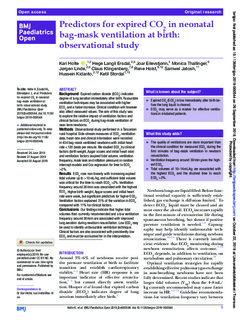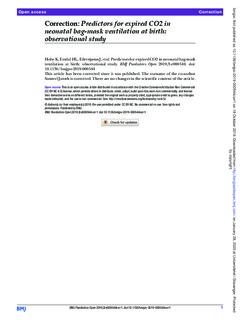| dc.contributor.author | Holte, Kari | |
| dc.contributor.author | Ersdal, Hege Langli | |
| dc.contributor.author | Eilevstjønn, Joar | |
| dc.contributor.author | Thallinger, Monica | |
| dc.contributor.author | Linde, Jørgen Erland | |
| dc.contributor.author | Klingenberg, Claus | |
| dc.contributor.author | Holst, René | |
| dc.contributor.author | Hussein, Kidanto | |
| dc.contributor.author | Størdal, Ketil | |
| dc.contributor.author | Jatosh, Samwel | |
| dc.date.accessioned | 2020-01-28T09:57:24Z | |
| dc.date.available | 2020-01-28T09:57:24Z | |
| dc.date.created | 2019-10-03T09:11:16Z | |
| dc.date.issued | 2019-09 | |
| dc.identifier.citation | Holte K, Ersdal HL, Eilevstjønn J, et al. (2019) Predictors for expired CO2 in neonatal bag-mask ventilation at birth: observational study. BMJ Paediatrics Open, 3:e000544 | nb_NO |
| dc.identifier.issn | 2399-9772 | |
| dc.identifier.uri | http://hdl.handle.net/11250/2638275 | |
| dc.description.abstract | Background Expired carbon dioxide (ECO2) indicates degree of lung aeration immediately after birth. Favourable ventilation techniques may be associated with higher ECO2 and a faster increase. Clinical condition will however also affect measured values. The aim of this study was to explore the relative impact of ventilation factors and clinical factors on ECO2 during bag-mask ventilation of near-term newborns.
Methods Observational study performed in a Tanzanian rural hospital. Side-stream measures of ECO2, ventilation data, heart rate and clinical information were recorded in 434 bag-mask ventilated newborns with initial heart rate <120 beats per minute. We studied ECO2 by clinical factors (birth weight, Apgar scores and initial heart rate) and ventilation factors (expired tidal volume, ventilation frequency, mask leak and inflation pressure) in random intercept models and Cox regression for time to ECO2 >2%.
Results ECO2 rose non-linearly with increasing expired tidal volume up to >10 mL/kg, and sufficient tidal volume was critical for the time to reach ECO2 >2%. Ventilation frequency around 30/min was associated with the highest ECO2. Higher birth weight, Apgar scores and initial heart rate were weak, but significant predictors for higher ECO2. Ventilation factors explained 31% of the variation in ECO2 compared with 11% for clinical factors.
Conclusions Our findings indicate that higher tidal volumes than currently recommended and a low ventilation frequency around 30/min are associated with improved lung aeration during newborn resuscitation. Low ECO2 may be used to identify unfavourable ventilation technique. Clinical factors are also associated with persistently low ECO2 and must be accounted for in the interpretation. | nb_NO |
| dc.language.iso | eng | nb_NO |
| dc.publisher | BMJ Publishing Group Ltd. | nb_NO |
| dc.rights | Attribution-NonCommercial-NoDerivatives 4.0 Internasjonal | * |
| dc.rights.uri | http://creativecommons.org/licenses/by-nc-nd/4.0/deed.no | * |
| dc.subject | pediatri | nb_NO |
| dc.title | Predictors for expired CO2 in neonatal bag-mask ventilation at birth: observational study | nb_NO |
| dc.type | Journal article | nb_NO |
| dc.type | Peer reviewed | nb_NO |
| dc.description.version | publishedVersion | nb_NO |
| dc.rights.holder | © 2019 Author(s) | nb_NO |
| dc.subject.nsi | VDP::Medical disciplines: 700::Clinical medical disciplines: 750::Pediatrics: 760 | nb_NO |
| dc.source.pagenumber | 9 | nb_NO |
| dc.source.volume | 3 | nb_NO |
| dc.source.journal | BMJ Paediatrics Open | nb_NO |
| dc.source.issue | 1 | nb_NO |
| dc.identifier.doi | 10.1136/bmjpo-2019-000544 | |
| dc.identifier.cristin | 1733291 | |
| cristin.unitcode | 217,13,0,0 | |
| cristin.unitcode | 217,13,2,0 | |
| cristin.unitname | Det helsevitenskapelige fakultet | |
| cristin.unitname | Avdeling for kvalitet og helseteknologi | |
| cristin.ispublished | true | |
| cristin.fulltext | original | |
| cristin.qualitycode | 1 | |


